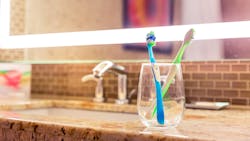Truthfully, I hadn’t given it much thought. I’ve even read some blogs saying that when you flush the toilet the spray can travel up to six feet, sending E. coli everywhere. But seriously, who has time to worry about all the things there are to worry about? Frankly, in my house I’m lucky if everyone remembers to flush the darn toilet!
Then I went to move my son into his college apartment, during a pandemic no less, I started thinking about what his toothbrush would be mingling with and what to do to keep him and his roommates safe.
These infection control thoughts have stopped centering around the operatory and entered our everyday thinking. Just touching the shopping cart handle or the credit card reader now have me visualizing what microscopic things might be crawling on my hand, and then on my face when I touch it. By the way, who knew how often we touch our faces?! Now all I can envision is little germ monsters jumping from the roommates’ toothbrushes onto my son’s. And don’t get me started about the toilet flushing!
What the experts are saying
So, what are the experts telling us about proper toothbrush storage? The ADA website recommends this:1
- Toothbrushes should not be shared. Sharing a toothbrush could result in an exchange of bodily fluids and microorganisms between people.
Rinse the toothbrush thoroughly after each use to remove any remaining paste and debris. - Store toothbrushes in an upright position after use and allow them to air dry. Storing a moist toothbrush in a closed container promotes microbial growth more so than leaving it exposed to the open air.
- Toothbrushes should be replaced approximately every three to four months or more often if the bristles become matted or frayed. The effectiveness of the brush decreases as the bristles become worn.
So, if we follow these recommendations, putting our brushes in a closed container is a bad idea because of microbial growth. What are other ways we protect our bristles from cross-contamination? Bathrooms are only so big, particularly a college apartment bathroom, so bristle distancing seems impossible, and having my son keep his brush in his room is a surefire way to ensure he forgets to brush.
Then I remember hygienist Jill Meyer-Lippert of Side Effect Support talking about toothbrush covers when I interviewed her on the Your Dental Top 5 podcast about her top 5 tips for cancer support. She discussed how different covers could protect the toothbrush bristles from bacteria while allowing it to dry out. Which, for those going through cancer treatment, is huge for decreasing risk for any kind of infection. But until I saw my son’s bristles sitting near this stranger’s bristles, I hadn’t thought about it for everyday use.
Toothbrush covers are numerous in styles and designs, from plastic to cloth and more. Clearly, though, the one key feature is that air can penetrate the cover to assist with the drying of the bristles and the prevention of harboring bacteria. Breathable toothbrush covers are quick-drying and protect your brush between brushings while creating an environment that isn’t conducive to breeding bacteria. But do they work?
Put to the test
I set up a very nonscientific study in my bathroom to ensure that a toothbrush cover was allowing the brush to dry out and not simply breeding microbes and creating a whole different problem. First, I brushed my teeth with my Sonicare, and then my Burst toothbrush. I placed a breathable cover on the Sonicare and left the Burst to air dry. I checked the brush two hours later and the Sonicare was dry while the Burst was damp. Then I thought the difference could just be because of the different bristles. So, then I took two identical Sonicare heads and brushed my teeth for one minute each. I placed a cover on one and left the other to air dry. I set a timer for one hour with the plan to check them each hour until they were dry. Well, after the first hour the head with the breathable cover was bone dry! And I mean like I hadn’t used it in a week crunchy dry and the uncovered head was still wet. Wow! That was shocking. So not only is the head protected from whatever is in the bathroom air, but it’s safe from multiplying bacteria in its cover.
Bonus
I learned through my research that there are hospitals that are now using toothbrush covers to prevent secondary infections. As we begin to pay more attention to the oral-systemic connection, I can see these becoming a necessity in hospitals, nursing homes, and schools. I can’t wait for the next time I travel to open up my toothbrush case and have my brush fresh and ready to go, not gross and damp smelling.
Reference
- Oral health topics: Toothbrushes. American Dental Association. Updated February 26, 2019. https://www.ada.org/en/member-center/oral-health-topics/toothbrushes
About the Author

Amanda Hill, BSDH, RDH, CDIPC
Amanda Hill, BSDH, RDH, CDIPC, is an enthusiastic speaker, innovative consultant, and award-winning author who brings over 25 years of clinical dental hygiene and education to dentistry. Recipient of OSAP’s Emerging Infection Control Leader award and an active participant with the advisory board for RDH magazine, DentistryIQ, and OSAP’s Infection Control in Practice Editorial Review Board and membership committee, Amanda (also known as the Waterline Warrior) strives to make topics in dentistry accurate, accessible, and fun. She can be reached at [email protected].
